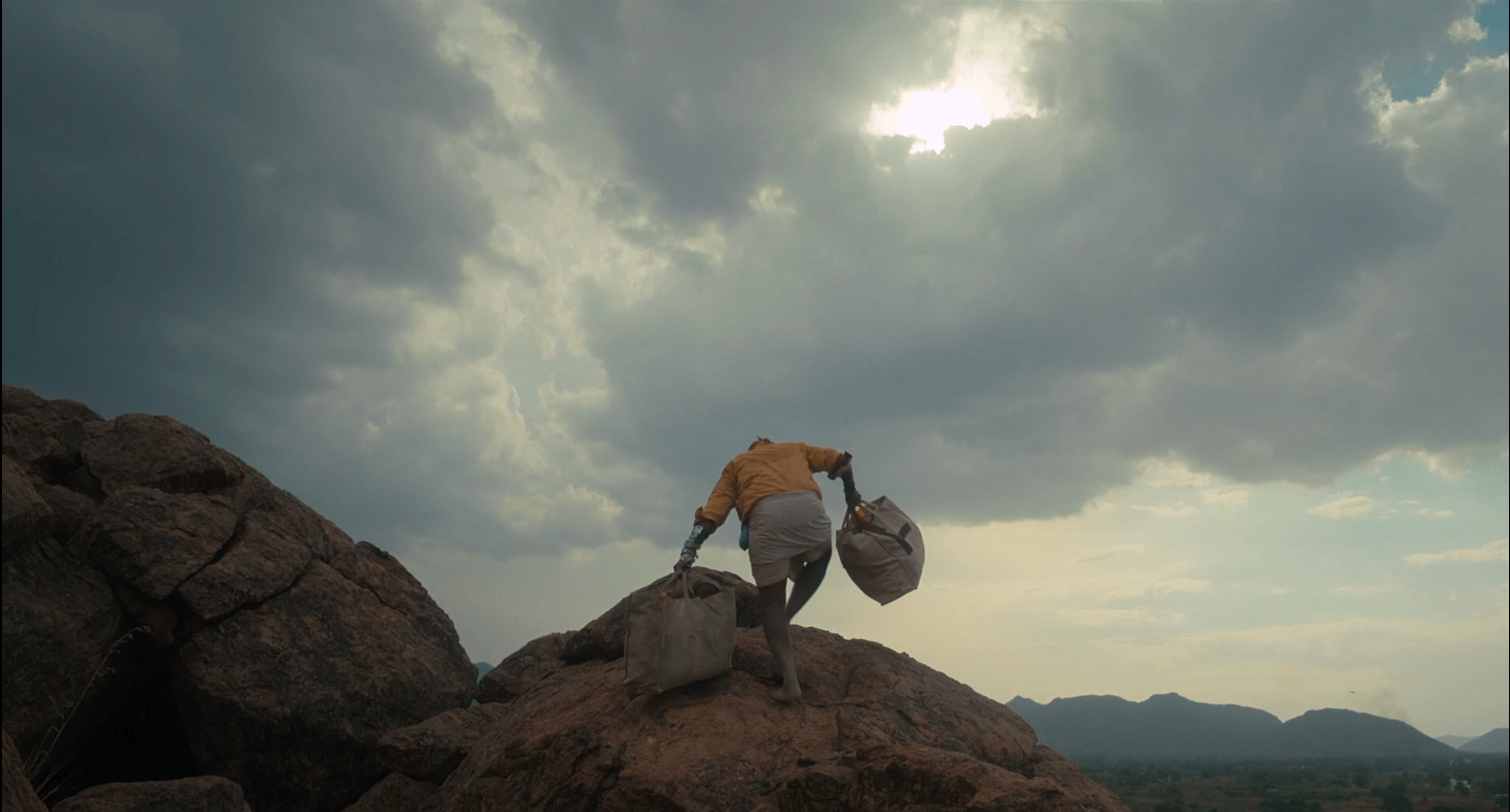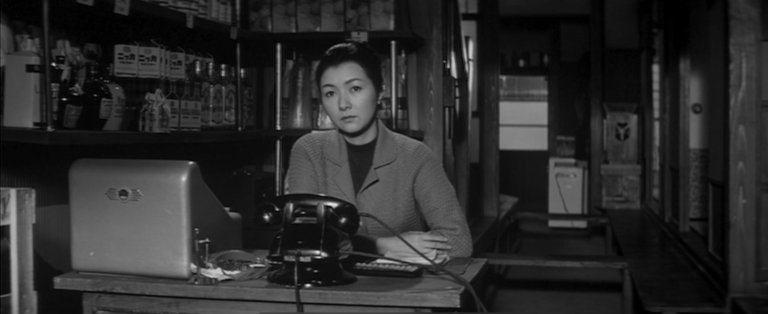It’s only right if I record the first sensations that I felt as this experience ended –
எத்தனை கோடி ஆண்டுகள் ஆனாலும், இப்பூமியில் கரிசல்காட்டு உழவரின் வியர்வையால் வளரும் பயிர்களை வாடைக்காற்று உரசும் வரை, என் பிறப்பை இயற்கை இச்செம்மண்ணிலே நடத்தி கொண்டே இருக்க வேண்டும்.
As I sit down to write this, I feel that at every juncture of this essay I stand to fall onto the side of rambling inchoateness. I feel much like Konstantin Levin, the male protagonist in Tolstoy’s Anna Karenina, right before he rushes out of the threshing floor in a spirited fever towards the wilderness. Regardless, I feel it right that I’d rather use the construct of words to express what this film inspired in me rather than have it swim and sink as time passes.
Kadaisi Vivasayi, as a film, emanates from a place of tremendous purity. Unsurprisingly, the few films that have inspired seismic changes within me have been also found their birth in this space of purity. They don’t have any roots that shoot up from acrimonious soil. Caste hatred, the ever-pervasive line of division across India, does feature in the movie. But when one of its gatekeepers rises in fury against his son’s decision to incorporate everyone into communal worship, it gets a back-of-the-hand dismissal. This directorial treatment brought to my mind an interview that I had read right after watching Aparajito. Ray had mentioned that it did occur to him to place a love interest for the son as he drifted away from his mother. After the first screening, he felt glad that he didn’t. Elsewhere in Hong Kong, roughly half a century afterwards, Wong Kar-Wai decided not to reveal the faces of the principal characters’ spouses, who had decided to elope. So, what is the common line across these three films that I hold dear to my heart? Throughout their narratives, they never gave me an effigy to burn. My naïve mind could have blamed the woman for separating a man and his mother in Aparajito, two senseless individuals for derailing their spouses in In the Mood for Love, and land-grabbing loan sharks to curse at in Kadaisi Vivasayi. Their conscious choice to give me no easy exit from contemplation and introspection give them their mirror-like quality. They house no vestige of spite towards anything or anyone within them. This quality, for me, is what will make them films that I will revisit as I progress through life.
Kadaisi Vivasayi is also different from its predecessors in Tamil cinema. Usually, any agriculture-centered film in our industry walks down a two-pronged road. On one hand, we have brave, stache-twirling men who bleat that they are proud agriculturalists. There’s usually a montage of them working in the fields and a spate of dialogues that follow action sequences as to how their pride of being agriculturalists can never be dampened. Their incessant need to hammer into you their pride in their identity relegates to the backseat the actual activity that lends them that title. On the other hand, the farmers are turned into pity cows. Their oppression is magnified and there’s usually a protagonist that steps in and alleviates their problems. Here again, the protagonist becomes larger than the profession that he battles for. Kadaisi Vivasayi abandons this route altogether. It doesn’t position Nallandi ayya as someone who needs pity, nor does it position him as someone whose identity is merely a point of differentiation. It pierces through that superficial level of assumed identities and begins to diffuse raw emotions and vulnerabilities at the most human level. It makes you nostalgic for a place and time you have never lived in. Kadaisi Vivasayi would make someone alien to Tamil culture feel much the same way I felt when I watched In the Mood for Love. I’ve never lived in Hong Kong, but the emotions that the characters exuded through those rose-tinted streets make me yearn for a city and time that I’ve never lived in.
The whole movie, when placed in the context of Tamil movie-making and culture at large, feels like such a refreshing breath of air that fills your lungs. For years, it has always been a common trend for many to ring with pride for any tributary that contributes to our identity, be it language or caste. We become truculent the moment we see a threat to it. In the larger context of colonizing forces, this makes sense. We fought an oppressive, invidious force that threatened the fabric of our civilization for 200 years. By the end of that long battle, the fight and that hard-earned identity became more important than the professions and traditions that lend themselves to it. Kadaisi Vivasayi and Nallandi ayya exist in a place that is somewhat still in that pre-colonial space. They continue to live with the land and the purpose that it lends them. When sly loan-sharks try to entrap him, he softly responds – “adhu irrukurappa naanum kalaila vellana endrichu thanni paacha poran. Adhuvum illana aparam naan eppadi endrikkuradhu? (As long as I have the field, I wake up early and go to water it. If I sell it, how will I wake up in the morning?)
Again, this isn’t an indictment against films that do focus on identity. We are social creatures, and we are constantly questioning our place in society and what our birth and our professions lend to us. It’s just that in this industry we’ve erred in the direction of identity battles for far too long and we have ended up with a surplus in this discourse. Rarely have we had films that leverage the medium and truly tackle the identity strifes across our land. Pariyerum Perumal and Karnan are both diamonds in the rough in that regard. They both brought to fore more evocative examinations of the individual identity and communal identity in society. But this focus on identity was never complimented with expositions of purpose. Manikandan in an interview after the film stated that there are already rural films that focus on identity and conflict. Kadaisi Vivasayi was a deliberate attempt to drop the discourse on animosity. He wanted to subvert the traditional image of villages being grounds of caste war. He gently clips us behind our ear to say that there are people here who live hatred-free lives and are the true living remnants of our ancient communities that have always been tethered to the purity of the soil and the soul.
Manikandan couldn’t have chosen a more perfect example to showcase this tethered purity. Nallandi ayya, in life and on-screen, lives willfully as a technological recluse. His house has no electrical appliances, he owns no tractors, nor does he own a cellphone. In every sense, he is still a man who hasn’t been swept away by the flood of progress. His age only punctuates this lifestyle. His feet slowly trod across the Usilampatti landscape as he walks his cows towards his field. He sleeps under the full-moon sky like a picture of tranquility. His indeliberate slowness commands your brain to reach his pace and see his life as he lives it. His thick, coarse Madurai accent reminds me of all the old men that I’ve seen sitting on thinnais as I’ve hopped from temple-town to temple-town in Sivaganga. The rare moments when his face steals a smile, as when he mischievously suggests that appalams are a good remedy for leg sores, you find yourself biting your lip with joy. In other tender moments, when Ramaiya states that birth guarantees death, his swift aama (yes) and his cloudy, tear-filled eyes tell with such force that he understands the reality of death more so than anyone else. No wonder Manikandan stylized his name as deivathiru (god-like) Nallandi ayya. This man has well and truly crossed into that realm.
As you zoom out from his reality, you come to sense that this film has a broader and unique proselytizing quality. I honestly didn’t expect that for four days after the movie, I would be jamming to Karpanai Endralum, Karchilai Endralum (May you be God or stone) by T.M Soundarajan. Listening to it doesn’t make me devotional or urge me to pledge my allegiance to Murugar. Murugar may have been the primary god in the movie, but it features other gods as well – Ayyanar and Karuppar. I decide to stop the track and ask myself why was I listening to this repeatedly? What is the exact sensation that this song is inciting in me?
I found two reasons. On the surface, the song symbolizes the waking of a village and the bustle that follows. Manikandan himself plays it over a montage of the village waking up to set the chores of the day into motion. That feeling of wanting to be in this harmonized rise and fall was dominant at this level. But besides the song itself, there is a strong undercurrent that is driving the movie. Murugar, Ayyanar, and Karuppar all have one thing in common – they are all communal gods that demand communal worship. From the early beginnings of Tamil culture, worship has always been communal, and the gods have always been described as mortals who transcended this realm. Murugar has always been at the center of all Tamil worship worldwide as he is seen as our earliest ancestor. Early in the film, an elderly man who brings the younger villagers back to the kuladheivam kovil (holy shrine) says in response to their doubts over why ancestors are worshipped as God – “namma aalunga enna solrangana, ullathai kadandavar dhan kadavul” (Our folk say that those who have broken free from their thoughts are God). Since they rose from amongst us, the belief is that they become our guardians and our guides. Worship and devotion, owing to this, has always been something that everyone came together to do. At this deeper level, the film strives to revive a sense of community amongst those people through the tides of worship. As you view all of this, in a world where every individual is slowly becoming an island separated from others, you develop a strong sense of wanting to return to simpler times where you stood shoulder-by-shoulder with who you began with. Manikandan may not have intended everything that I recall. But that’s the beauty of any work of art. Thousands take out twice as much, if not more, than what the creator put into it.
What he did intend though was to capture that landscape in all its sprawling splendor. When his name appears before the movie begins, it’s almost comical to see how many areas of pre- and post-production come under his ambit. Any budding director sat there must think of it as a nightmare. To edit, to cinematograph, to direct, and to write. It seems daunting to even do two of these four. But, apart from the grueling shift he might have put in, the dividends are so clear. He would be able to visualize a scene with a lot more nuance as he pens it owing to his background as a cinematographer. On set, he can think in advance as to how he would stitch his film together and where he would need to dolly, zoom, and tilt. He can rack up footage to pronounce the vastness of a landscape using three zoom ranges and edit them perfectly to dimunitize workers in a field. Being able to do these four roles is one thing. Being able to do them with such cohesion separates him from the rest. Even with a stirring soundtrack gifted to him by Santhosh Narayanan, he carefully sews it in to punctuate the pockets of silence that precede it. In circumstances like these, directors tend to splurge the soundtrack without a real understanding of background ambiences. Despite sync-sound being the norm in Western productions, it is still beyond the budget of smaller films in the East. I’m glad that Manikandan was obstinate in his usage of sync-sound – even the slightest of breezes pull people through the screens and onto the fields.
This fastidious obsession with realism is what makes this film a real larger-than-life experience. The cast makes this factor stand out. Their levity and their innocence are free from acting nerves. They feel so at ease in cracking jokes, bowing to superstitions, and tuning in to a conversation with unfeigned interest. In Tamil, we have a word – veguli – to denote someone who is shockingly innocent. In the case of these villagers, veguli would be a misnomer. Unlike the vast majority of the world, they are living without needless filters. In one of the film’s finer moments, two people who discover their shared love for agriculture work out the difference between crops and weeds. I think living close to that land physically while still being so removed from it makes their newfound love a lot more accessible to an audience that may live a country and a half away. It’s almost as if the movie doesn’t chide you for leaving your roots. It fondly calls you back, wherever you may be, to show you how beautiful an inhibition-free life can be in those lark-filled fields. Even as he does all of this, Manikandan still finds a way to pepper in some social commentary. Through Yogi Babu, one of the only two professional actors in the movie, he jibes about the plight of the farming community. In other interactions, he manages to underline the pitfalls of modern farming and yield obsession. He manages to insert measured criticism without making the film revolve around these detractors.
Beyond all of this, there’s an element in this film that keeps oozing something into you. My initial fears of derailment from my original purpose of writing this recollection stem from this element. This element is Ramaiya, portrayed by Vijay Sethupathi. Before I say anything, I only wish to record that this man has been an absolute gift to this industry. Not merely for his ability to surpass everyone else with his ability to act, but to continue to fight against hardships to bring movies like this to the theatre. He shouldered the burden of producing it, paid interest, and insisted that this movie will be screened before an audience. When he said in the interviews that he cannot resign himself to the notion that cinema is merely a form of entertainment, I sensed that he felt that more acutely in recent years. My sensation didn’t prove me wrong. Within merely 15 minutes of screen-time, he brought a rare, mythical layer to this film.
Ramaiya, a feverish Murugan devotee, made me feel as if this was someone out of a Dostoevsky novel as soon as I laid eyes on him. He is on a tangent that is opposing that of the village itself. He is labelled as a good man who has been left shattered by the harsh truth of death. Since the death of his beloved, he and the village split into two tangents – the former moving ever closer to spiritual submission and the latter towards a slow, spiritual death. For him, the woman he loved fulfilled his purpose in life. Without wanting to bite into the reality of her loss, he wanders across the land, hoping that he’d find someone else to affirm her existence and in turn, his purpose. He uses God as a stop-gap as he believes that Murugan is the only one who continues to see her and recognizes what the village can’t. He visits Nallandi ayya because he believes that he’s still the only one in the village who acknowledges her presence. But there’s also the possibility that he feels that Ayya’s benevolence and awareness of the events that transpired prompt his acknowledgement. It’s only when he comes across the saint that senses her presence does he feel true liberation. It brings me back to the saying in the film – “ullathai kadandavar dhan kadavul”.
Months ago, I was going through a series of talks by Jiddu Krishnamurti, and a very similar statement struck out – “When thought assumes sensation, desire is born”. To exist, in the interregnum, between sensation and thought, is what translates to liberation, at least in the context of this film. Both the saint and Nallandi ayya exist in that space of spiritual sanctity and Ramaiya attains it as well. Before he bids a firm farewell to the village, he asks them to pray to their ancestors, to the ones who have broken free from their thoughts, and leaves. Even as I’m writing this, I feel that words are a laughable substitute for this phenomenon. I can propound a 1000-page treatise on this supposed interregnum and still come nowhere close to explaining it. An explanation for this phenomenon is impossible because it exists in the domain of sensation and can’t be accessed while existing in the domain of thought. Alternating between backspace and enter, I feel that the only thing to record is this – you attain that liberation, not through words or vicarious experiences. You attain it only when it thunders through your senses.
Despite this tangent, I’m glad that Manikandan didn’t choose to go on the philosophical road. He’s still aware of his audience. They are in dire need of hope and direction, not an existential exploration. I’m glad he showed them realizing their dream of coming together and celebrating their ancestors after a long time. The whole point of this film was to display the beauty of ascetic living, oneness with nature and importantly, how a community that drifted away from this finds its way back. The peacock at the end may or may not have been Ramaiya, but that was not the point. It was a token gesture, much like the lyrics Karpanai Endralum, Karchilai Endralum. May you be God, nature, or collective human imagination, thank you for bringing us back closer to our roots.
There are so many takeaways from this film, but the one that I’d like to keep the most in the absence of others is the honest reality that is portrayed. Our villages are dying gruesome deaths, and in doing so, they are taking thousands of years of history that is seeped deep in their bones along with them. I don’t know if the years I have left will show a Tamilnadu that has changed to leave its shackles behind. I don’t know if the growth that follows would lead to us following the paths of these advanced nations before us. But if these two hours of Manikandan’s ode have told me anything – I will fight tooth and nail to ensure that the traces of human pureness that our 3000-year-old history has conferred upon us aren’t left further behind.





